This excerpt is from SEO in the Gemini Era by Marie Haynes ©2024 and reprinted with permission from Marie Haynes Consulting Inc.
Much of the SEO advice you see online today is based on shared community insights about search, gleaned from the days before Google actively embraced AI.
So much of what many of us do as SEOs and consider standard practice is based on a search engine that was a list of heuristics – handwritten rules programmed in by humans. So much has changed.
Let’s say you are assigned to write a new article for the website you are working on.
You probably start with keyword research because we know that to appear relevant to a search engine, you need to write content that covers a topic in depth and use keywords that are semantically related to your topic.
Much of the content we have on the web today came into being through a process that looks like this:
- Do keyword research to see what your competitors have written.
- Create content that is similar, but perhaps just a little better or more comprehensive than theirs.
- Do keyword research to see what others have already discussed that you haven’t included.
- Create content that also addresses these topics.
- Research related questions that we can answer so we can write content that is even more relevant and comprehensive for search engines.
- Create more content to answer these questions, even if Google already has content that answers these questions.
Nothing in that process ensures that we create content that is truly original, insightful and considerably more useful than what exists online.
And that is exactly what Google wants to reward!
An SEO agency often spends many hours a month improving the technical SEO of a site, improving the internal link structure or perhaps getting external links and listings. These are all things that can potentially make a web page look better to a search engine.
These aren’t bad things to do, and some of them have the potential to improve a site. But again, those things are unlikely to improve the content on a page. significantly more useful for searcherswhich again is what Google wants to reward.
I want to be clear here. I’m not saying technical SEO is dead.
There are benefits to having a technically sound, fast site that search engines can easily navigate and understand, especially if you have a large site.
Schema can still do wonders when it comes to helping Google understand your business and its EEAT, especially a new one. There are some verticals where technical improvements will give you enough of an advantage to improve rankings to some extent.
There is one thing that makes content more useful.
Are you ready for this deep, insightful secret?
Here it is…
The secret to having content that Google considers more useful than others is to have content that users find useful..
A change of mindset is needed for SEO’ers
For over ten years, my main source of income has been advising businesses on how to improve their search engine visibility.
I’ve read every word Google publishes about what they want to reward and have compiled pages of checklists, training documents, and advice.
I had one goal: Help people understand what Google rewards and help them become that result..
Do you see the paradox hidden in that statement? The more I think about it, the more ridiculous it becomes!
I didn’t realize all along that while I was preaching about creating People First Contentas Google now calls it, a lot of what I did was much more focused on Satisfy Google then searchers.
Other SEOs are now picking up on this mentality. What users do on our websites is hugely important. User actions are a huge factor in Google rankings.
In the past, I’ve always viewed Google’s guidelines for creating useful content as a checklist of things we could improve.
Do you have an author bio? Check. Good descriptive headline? Check. Demonstrate experience? Information gathering? Another check.
My first book on creating useful content takes you through multiple checklists like this one. You can See improvement by going through these checklists.
I actually know this because people often contact me to say that they have made changes based on the checklists and that they see improvements.
But it turned out that Google did not give us a list of criteria that we could analyze in the form of a checklist!
I now realize that Google actually told us the following: Our systems are built to reward the kinds of things that people typically find useful and trustworthy. And if you want to know what that is, here are some ideas.
It is not a checklist, but a list of the types of things seekers likeThe algorithm is designed to reward what searchers like.
An author bio isn’t a ranking factor, but in many industries, users appreciate seeing their authors’ experience showcased.
Core web vitals, metrics used to measure load time and other similar things, used to be a score we aimed for… but the reason we’re working on improving core web vital scores is because users prefer pages that load quickly and don’t jump around.
It’s not like Google has a checklist or a scorecard when it comes to the quality of each page. Google doesn’t have know what exactly your content contains and whether it is of high quality.
As we discussed earlier, search is a complex AI-driven system that trying to predict what searchers will find useful.
Here’s the full list of “ideas” Google gives us to help us understand what searchers might find useful:
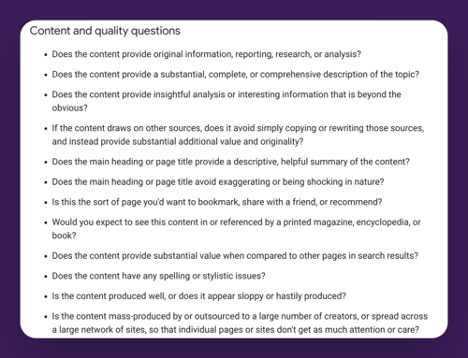
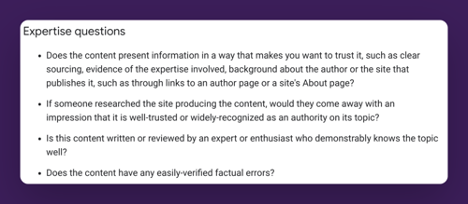

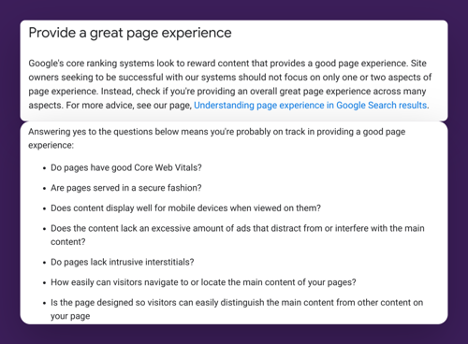
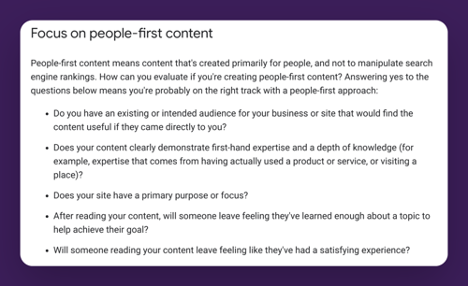
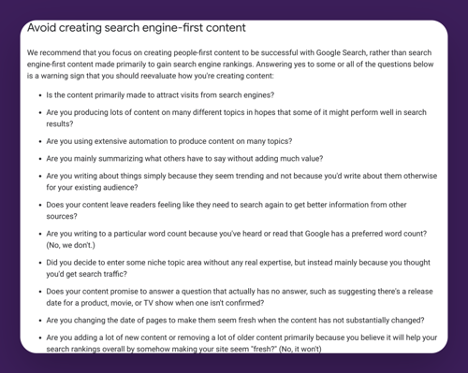
In the past I have taught about looking at these ideals one by one for inspiration on how to improve your site, and I still think it is very valuable to do so.
But now I realize I missed the main point. I’ve been thinking about useful content as an SEO.
If you’re truly creating People-First content, you’re already aligned with Google’s helpful content recommendations.
I had it wrong.
If you know what your audience needs and what questions they have, and you create content that answers those questions, you’re on your way to creating the type of People-First Content that Google wants to reward.
People First Content Is:
- Usually made by people with real experience in a particular subject. A store that sells a product to real customers is more likely to produce useful content that advises people about that product. A person who provides professional advice on a topic is more likely to have fresh content that understands the current needs of that audience.
- There is one exception to this rule: Sometimes authority can trump experience. We see this when a site like Forbes ranks [BBQ reviews]. In this case, Forbes is likely seen as a place that users trust because of its overall authority in journalism. It has enough EEAT to be considered a reliable answer to this query. And as long as searchers indicate that they are satisfied, it will continue to rank. (I think this will change as we learn to create truly useful content. We should see more truly useful content from expert-recommended topics.)
- Content that provides real value to searchers.
- Clearly and concisely written in a manner that is easy to understand.
- Original and insightful.
But how does Google determine this?
In the next section, we’ll discuss something that has been largely unknown to SEOs until recently: how much Google uses user engagement signals.
It turns out that Google knows what’s useful to people, because signals from every interaction that takes place in a search query are fed back to machine learning systems with one goal in mind: for the systems to learn how to best work together to provide the searcher with information he or she is likely to find most useful.
Notes
[1] Creating useful content. Marie Haynes. 2023. https://mariehaynes.com/product/creating-helpful-content-workbook/
To read the full book, SEJ readers receive an exclusive 20% discount on Marie’s book, workbook, and course bundle. The discount will be automatically applied by following these links:
More resources:
Main image: MT.PHOTOSTOCK/Shutterstock
